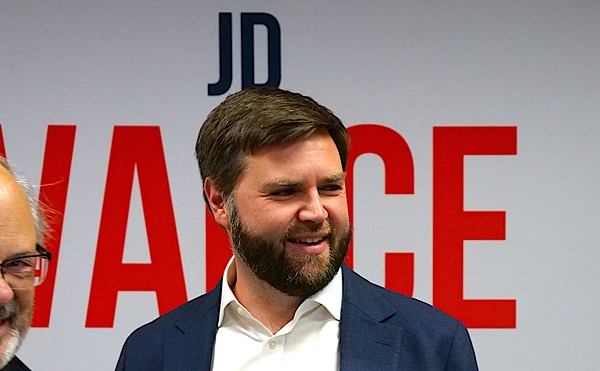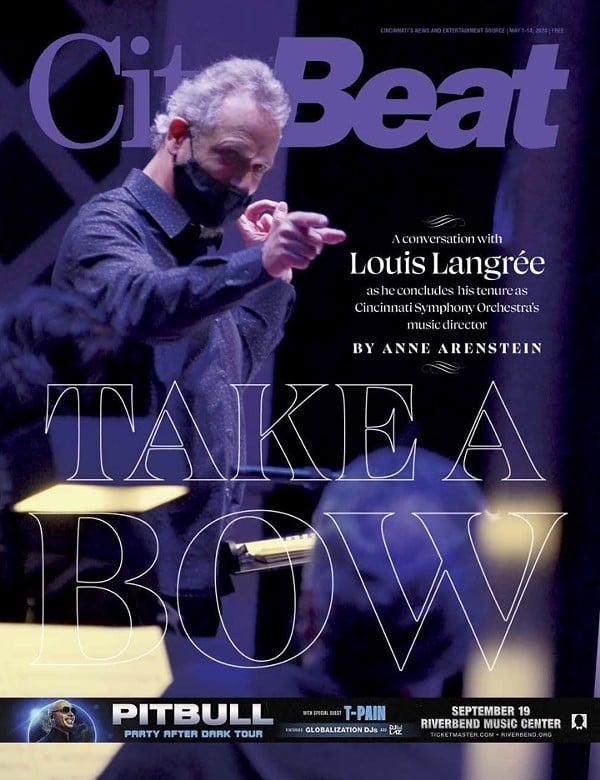F
or once, I feel kind of normal,” Chris Amberger says today.
He was an eager 17 when he joined the National Guard in 2002; his first tour of Iraq started early in 2005. Within five months he saw one of his leaders burn to death when his Humvee was hit by a roadside bomb. Two months later, it was Amberger’s turn.
“It was a suicide car bomber. I was 45 feet away,” he recalls.
It took military doctors a year and a half to piece Amberger back together. But his newly fractured mind lagged behind.
“I realized it the day after I got blown up,” he says, recalling his first memories of a German hospital. “I was having flashbacks, recurring nightmares. I’d be sleeping and I’d see a van, and it would evaporate into a fireball. I’d wake up clutching my chest and would be hardly able to breathe.”
The moment he recovered, he was shipped off to Afghanistan, then one final tour of Iraq.
Now 26, he’s been out of the military for three months and back to a regular IT job in Columbus. But his post-traumatic stress remains, and the flashbacks and angst that have followed him through it all are joined by new problems. He has trouble concentrating and angers easily. He steers clear of situations he has learned trigger flashbacks.
Amberger hasn’t seen a doctor since returning, but he’s found his own help for the horrors that envelop him.
“Once I was home, next thing I knew, I started smoking, and then, when I was in a difficult situation I didn’t get upset or irrational,” he says. “It helps me pay attention at work, and I can sleep.”
Amberger was never a stoner and isn’t one now. He says a little weed every other night just before bed quiets the racket of the war that his brain persists in firing at him. But buying illegal weed makes him nervous.
“There’s no reliable or safe access to it,” he says. “Everybody seems a bit shady. And serving as long as I did with a spotless record, I have a lot to lose.”
Briefly in 1996, there was an Ohio statute that could’ve helped people like Amberger. The “medical defense” law prohibited prosecution of anyone who could show a doctor’s recommendation for using otherwise-illegal weed. It also made Ohio second only to California in attempts to legalize the drug. But the state’s progressivism was short-lived; a more conservative legislature overturned the law within six months.
Since then, marijuana has been substantially decriminalized here.
Nowadays, having less than 100 grams (roughly 3.5 ounces) will get you a ticket and a fourth-degree misdemeanor. But that’s still not enough to the myriad groups pushing for legal medical marijuana. For eight years, they have tried to get an Ohio law passed that would completely legalize — but regulate — medical pot here.
“It would be a huge relief,” Amberger says.
Sixteen other states and the District of Columbia have beaten Ohio to the punch. Ohio lawmakers have made various attempts over the years, failing each time to dislodge the issue from committee rooms.
A recent study by the nonpartisan group, Pew Research, revealed that 72 percent of Ohioans favor legalizing medical marijuana. In the wake of that report, pro-pot groups plan to take it to voters on the November 2012 ballot. In order to do so, they must get the ball rolling now.
These days, two factions have emerged in the world of pot legalization in Ohio, each with drastically different proposals for voters. And the two sides aren’t talking to one another. With the groups continuing down differing paths, some worry that they could snuff out their own efforts.
Give peace a chance
“It’s a shame,” Cher Neufer says between drags from a smoke — the regular kind — in the black-lit back room of a storefront on Lodi’s town square. The rural Medina County hamlet serves as headquarters for the Ohio Chapter of the National Organization for the Reform of Marijuana Laws (NORML). “Both sides could have sat down, debated and come up with what would be the best ballot initiative.”
Founded in 1970, NORML is one of the nation’s oldest groups advocating marijuana legalization. It requires state chapters to support every state or local effort to lighten up pot laws. And there are two in the works here: One that’s more lenient and favors state control, another that’s more restrictive but leaves enforcement in the hands of local government.
The standoff stems in part from neither group even knowing the other existed at the time their plans came together; by the time they found out, so much work had been poured into each initiative that it may have been too late to join forces.
And Neufer is stuck in the middle.
True to NORML’s mission, the 64-year-old retired programmer is preparing boxes of T-shirts and bumper stickers to take to the Mid-West Reggae Fest at Nelson Ledges. Lovingly referred to by many as “Marijuana Fest,” it’s a sure bet to drum up support for the Ohio Alternative Treatment Amendment, the lone initiative to seek NORML’s help.
In March, before she knew the Alternative Treatment group existed, Neufer was invited to meet with backers of what is now the competing ballot initiative, the Ohio Medical Cannabis Act of 2012.
“They were very secretive,” she says. “They wouldn’t allow me to bring anyone with me, and they wouldn’t let me read their petition. How can I endorse something they won’t let me see?”
Since then, her emails and calls to Cannabis Act backers have gone unanswered.
It’s rumored that Cannabis Acters might already be getting money from the deep-pocketed national Marijuana Policy Project or “maybe even Peter Lewis,” Neufer says, referring to Northeast Ohio’s own Progressive Insurance CEO, known for advocating marijuana legalization.
As a first step toward getting on the ballot, each group must produce 1,000 signatures that can be validated by Ohio Attorney General Mike DeWine.
Unlike its counterpart, the Treatment group makes it easy for Neufer and anyone else wishing to collect signatures for the cause: Its petitions are available for download on the group’s website. But this move also might have led to the failure of its first attempt to woo DeWine this summer. Of 2,143 signatures submitted, only 534 were deemed valid.
The problem was that petitioners collecting signatures did not correctly record the number of signatures gathered on the petition sheets, Treatment spokesman Ryan Maitland said at the time.
Neufer, who also is secretary of the medical-pot-friendly Ohio Patient Network, confirms the group is gathering signatures for its second petition attempt.
Meanwhile, the Cannabis camp is gathering signatures of its own, with hopes that using only trained petitioners will avoid any snafus. “We are professionals,” says spokeswoman Theresa Daniello, her voice ever-so-slightly suggesting that a certain other group is not.
But she is mum on many points.
“This is a business,” Daniello says, noting that the group operates under the guidance of a very experienced local CEO and plans to appoint a doctor to its board. But she will not name them. “We are still putting the puzzle pieces together,” she offers.
What’s the difference?
Backers of both groups insist that they are against full legalization of marijuana. But observers see medical legalization here as an important stepping stone to pot eventually becoming legal, like liquor. NORML, for example, operates nationally on three different platforms: Full legalization, medical legalization and legalization of industrial hemp production.
“We do what is best for the particular state, and in Ohio, medical legalization is best for the state,” Neufer says.
Also, every state that puts its own rules on the books sends a rallying cry to the feds to get out of the ganja game. Federal laws trump more lenient local ones, but as each state falls to pressure from pro-pot constituents, federal laws become more difficult and costly to enforce.
As evidence the strategy is working, proponents of legalization point to five separate bills currently bumping around congressional hallways; they would forbid the IRS from prosecuting taxpayers with medical marijuana income and allow lenders to finance medical marijuana businesses in other states. One would outlaw Uncle Sam from meddling in states’ marijuana decisions altogether.
“It will be very difficult for the federal government to enforce its own marijuana laws if over half the states have deregulated it or if more than half the population supports deregulation,” says Morgan Fox, spokesman for the Washington, D.C.-based Marijuana Policy Project.
The more restrictive Treatment Amendment mimics medical marijuana laws passed in other states and is similar to the bills that have failed to clear the Ohio legislature for the past eight years. Patients with a diagnosis from an approved list of ailments, a doctor’s written recommendation, and who register with the Ohio Department of Health could possess 3.5 ounces of pot and grow 12 plants for personal use without worrying about the misdemeanor charge that now hangs over their heads.
Registered cultivators could grow and dispense enough MJ for eight patients. Local zoning boards could prohibit the commercial sale of pot to patients within their municipal limits and could also forbid patients from growing weed in their own homes.
But to many, the most disconcerting provisions in the Treatment Amendment are that state and local lawmakers could pile whatever taxes or fees they see fit on the sale and cultivation of medical marijuana — and that local police departments would be responsible for enforcing the local laws.
Local control like this has caused problems elsewhere. In Oakland, Calif., the cost of a license to cultivate medical marijuana has skyrocketed to more than $200,000, putting such businesses out of reach for individuals and nonprofit groups.
“In some cases it’s been a city just trying to make as much money as possible, but in some cases (high taxes or fees) are to keep away too many customers and dispensaries,” Fox says. “They know only those serious about it will pay.”
Also lacking in the Treatment Amendment is a “medical defense” clause — a flaw that resonates loudly with Cannabis Act supporter Daniello.
Immediately after she delivered her fifth child seven years ago, the Geauga County resident developed severe back pain. “They tried everything — Neurontin, some kind of injections and pain pills,” she says of Cleveland Clinic specialists. “Nothing worked.”
Before she knew it, she was addicted to Percocet. “I was up to 12 a day,” says Daniello, a youthful, petite 43-year-old. She describes constantly impaired thinking that continued for three years while she took the drug, and she blames that impairment, at least partly, for the demise of her marriage.
Faced with a divorce and disgusted by the pain pills, Daniello threw them away and instead tried pot, which alleviated the back spasms and pain. But a little more than two years ago, she was caught with half a joint.
“They took my children away,” she says. “I don’t want this to ever happen to any other mother.”
Courts don’t usually take children over misdemeanor pot possession. But in Daniello’s case, she says, her estranged husband successfully used the charge in custody proceedings. After six months of negative THC tests, the children were returned, and Daniello has been relying on holistic pain relief techniques, like massage, ever since.
The irony, she says, is that nobody would have cared — and she wouldn’t have lost the kids — if she had kept taking all that Percocet.
The Cannabis Act would allow anyone charged with misdemeanor possession to escape the charge by producing a doctor’s recommendation for weed after the fact.
The Cannabis Act differs from the Treatment Amendment in other substantial ways. It allows a registered patient to possess twice the weed (7 ounces) and allows licensed growers to produce twice as many plants. The list of ailments for which pot can be prescribed under the Cannabis Act would be best termed as more “all-encompassing.” For one thing, the Treatment Amendment specifies “wasting” or “nausea”; the Cannabis Act includes all HIV-positive people, whether or not they are taking anything for it.
“We are taking a different approach,” says Cannabis Act spokesman Ben Morrison, 26, an untreated HIV-positive Cleveland Heights resident. The Cannabis Act would create a new state division, mirroring the Ohio Division of Liquor Control, which would limit state lawmakers’ and local municipalities’ control. Local lawmakers could prohibit commercial cultivators and marijuana dispensaries in their town, but they couldn’t prohibit state-registered patients from growing weed themselves.
Also, the Cannabis Act limits the taxes and fees on weed.
Most important to Morrison and Daniello, though, is that enforcement would rest solely with the newly created state division. Only trained agents could inspect medical marijuana dispensaries, much as liquor control agents oversee Ohio’s 477 liquor stores.
“Enforcement of the amendment is not with the local police departments,” says Daniello. “It’s between the patient and doctor. It’s nobody else’s business. Patients will not have to expect a knock on the door from armed officers.”
But Treatment Amendment spokesman Maitland complained that the Cannabis Act would increase the size of Ohio’s Constitution by 30 percent.
“It’s very clearly something that’s designed for commercial interests and not for medicine,” he said. “We were just going to go ahead and be cool with everybody and let it slide, and just do our own thing and ignore them.” But not anymore. “We are now taking offense to what they are trying to do in Ohio. It’s the most horribly written medical marijuana bill ever.”
The Marijuana Policy Project, meanwhile, says the Cannabis Act has potential. “Legalized medical marijuana has generally worked better where it has been under state control,” Fox concedes.
All parties agree that it would be very unlikely for both initiatives to wind up before voters. If both manage to survive the attorney general’s office, only one is likely to raise enough money to successfully complete the massive task of getting the 385,000-plus voter signatures needed for a spot on the ballot. And according to Fox, politically savvy pro-pot organizations are more likely to fund the initiative that is most likely to pass.
For now, it doesn’t matter whether one signs an initial petition for the Treatment Amendment or the Cannabis Act.
“Just be sure to sign one of them,” Fox says. “Or both.”
Maude L. Campbell is a writer for
Cleveland Scene , where this article first appeared.






